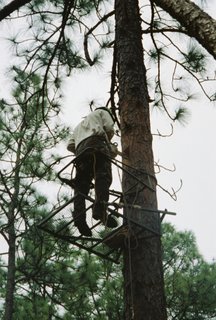
Kevin Messenger on the way to release a brown water snake. Kevin is conducting an intensive ten-year study of snakes at the Carolina Sandhills National Wildlife Refuge.
Excerpt from "Snake Cruising"
Kevin Messenger, a graduate of North Carolina State University, had undertaken “a huge project, a ten-year mark-recapture study” of snakes at the NWR. “I want to look at the biodiversity of snakes on the refuge, see which populations are going strong, which are dwindling” . . .
Snake populations at the refuge are not static. The first “herp study” at the refuge, Kevin said, was conducted from 1975 to 1977 by John Garton and Ben Sill of Duke Power Company, about the time of the first prescribed burns at the NWR. That study found no pygmy rattlesnakes. “From 1995 to 1997, Jeff Camper from Francis Marion University did a second study.” By then, pygmies were the most common species on the refuge . . .
“When I began my study, I found 2 or 3 pygmies a night. But if you go 50 miles up into North Carolina, they are endangered. What makes the Carolina Sandhills refuge so special that pygmies are abundant? That’s one of the things I want to figure out. I think that prescribed burning is a huge benefit for pygmies, though I’m not sure why.” He speculated that burns are a boon to fence lizards, a favorite pygmy food. After a burn, the lizards are camouflaged on the charred trunks of trees. “They hide more easily from birds” . . .
Visitors to the Carolina Sandhills NWR, Kevin continued, might not enjoy knowing that 3 of the 4 most common snakes he finds are venomous, though encounters are rare . . .
Carrying his snake stick, a long-shafted handling hook, Kevin strode down the trail to the cottonmouth sluice. I followed. Closely. It was 10 pm. The terrain was dark and tangled, a grassy bank leading to a precipitous path so narrow and overgrown that I had to place each foot directly in front of the other. Large spiders, orb weavers, hung in lacey webs from branches. I had brought a flashlight, an inconsequential thing with two AA batteries that was about as useful as a birthday candle in a haunted castle . . .
I said that I had heard that cottonmoths were aggressive.
"They are to other cottonmouths. But they're not as aggressive as people think. As long as you don't step on one, you're not likely to get bit." . . .








